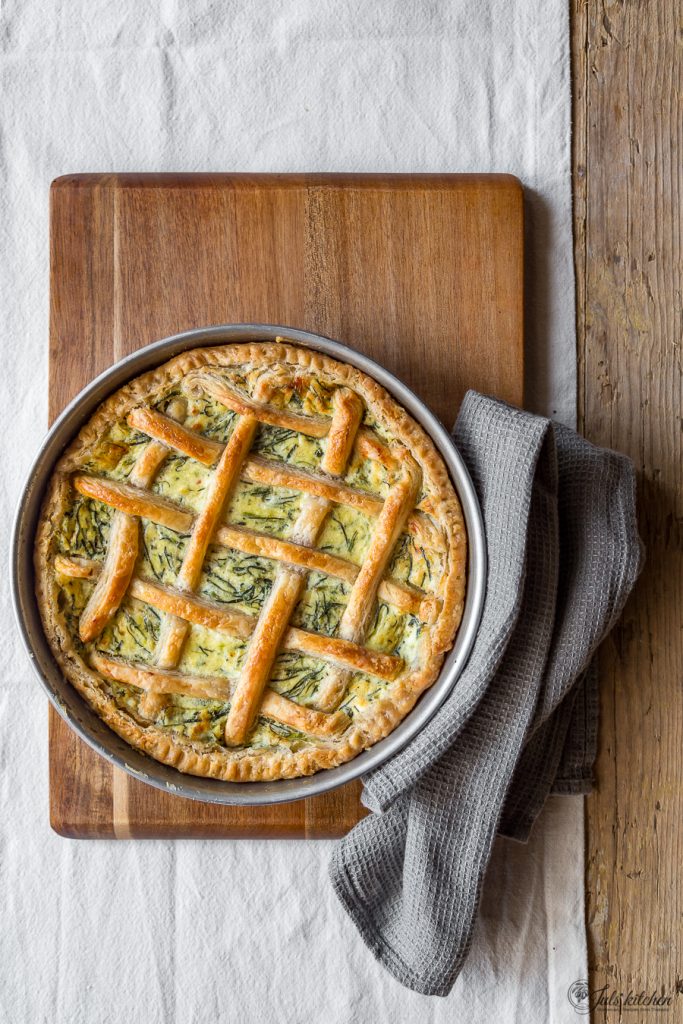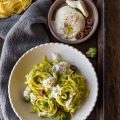The season of agretti. Two monk’s beard recipes for you.
In these days, the philosophy guiding my efforts to produce good content I could be proud of is perfectly synthetized in a Nicole Gulotta’s sentence I found in one her latest newsletters, a brilliant source of inspiration: in this writing life, the only thing we can control is whether or not we show up to the page.
So true, so powerfully true. The only aspect you can control is your commitment to show up, with a pen on a white page, with a hopeful look in front of a blank document, no matter what.
I got distracted along the way, though. It might have been the unexpected smell of a long-awaited Spring coming from an open window or my bad habit of overscheduling my week. It might have been a childish stubbornness that made me refuse to write a single word at the end of a tiring day in the kitchen, because I want to have the complete control of my life, and I deserve some rest, and a couch and a blanket, and the latest Grey’s Anatomy episode. If I sense a shy I should write a new post peeking out among my thoughts, that’s when I’d dig my heels in, throwing a mental tantrum with my sense of duty.
So, I was stuck. I desperately wanted to show up, to write, to enjoy that burst of inspiration that brings out the words of an inner conversation directly onto a page. I had fragments of sentences lingering on the tip of the pen, but I was never ready enough to commit, to sit down to write. I am the queen of procrastinating when I want, I am so full of imagination when it comes to find activities to postpone your duty. Just to name a few, I baked a loaf of bread and I made some jam.
The smell of that pot of strawberry jam simmering on the stove brought me back to my desire to show up, no matter what. I found myself in my mum’s kitchen, preparing my very first strawberry jam, it might have been a few months after I had started my blog: I felt again an untouched enthusiasm, the sheer pleasure I experienced in the freedom of writing just what I wanted, what I cared for, what made my heart sing.
Let it be Spring, with the smell of freshly cut grass on a Saturday morning, the hawthorn ready to explode in the hedgerows along our country roads, the mint growing again along the fence, the market stalls crammed with artichokes, tender peas, fava beans and agretti.
For years fava beans represented the arrival of Spring, their mildly bitter flavour a perfect match with fresh pecorino and thickly sliced salami on the first picnics, a welcoming ritual made of fresh tastes and informal food.

Recently, though, all I want is agretti.
Their scientific name is Salsola Soda, but they are known in Italy also as barba di frate, monk’s beard. They grow in sandy seashores along the Mediterranean coast, they are especially popular in Tuscany, but I can’t recall to have ever met them on a market stall until very recently. Now can also be found in UK, where they are quite trendy now.
The leaves of agretti look like chives, they have a succulent texture which gives a nice crunch when eaten raw. They have a salty, mineral, slightly lemony flavour, similar to spinach.
As Frances Mayes describes them, they are full of the energy of spring.
I buy them by the bunch during their short season, and use them liberally with pasta, with seafood, and especially as a side dish. Cleaning the agretti is a form of meditation, according to Fabio Picchi, a charismatic Florentine chef. You must rinse them in plenty of water and remove all the pinkish roots. One by one. Buy more than you would think is enough, as they behave just like spinach, they shrink in the pan once cooked.
I asked you on Instagram how you use them, and the common answer was: steamed, then drizzled in extra virgin olive oil and lemon juice. That’s it, the best way to enjoy agretti. Butter and anchovies are also a great match, as a poached egg on top. You can twirl them with spaghetti for a tasty first course, too.
My friend Steve at The Beehive quickly blanches them, then he sautés the agretti with confit cherry tomatoes, capers and olives: enough to pay them a visit in Rome, isn’t it?
I prepared two recipes for you today: a first course, rich and inviting with anchovies and burrata, and a savoury pie that you can use for the first spring picnics.

Spaghetti with agretti, burrata and anchovies
The simplest spaghetti aglio, olio e peperoncino, spaghetti tossed with a garlicky olive oil and chilly pepper, are a decent meal on its own. Add agretti and you can turn this evergreen first course into a Spring meal.
Agretti team up perfectly with rich milky burrata, but feel free to substitute it with fresh mozzarella, or buffalo mozzarella. Anchovies are probably one of the ingredients that best complement agretti, so be generous with them. In this dish, they are melt in the garlicky olive oil where agretti are cooked and they also give flavour to toasted breadcrumbs, to use just like grated cheese on pasta.
Spaghetti with agretti, burrata and anchovies
Print Recipe Pin Recipe Share by EmailIngredients
- 350 g of agretti, cleaned
- 2 tablespoons of extra virgin olive oil
- 1 scant teaspoon of salt
- 50 ml of water
- 1 clove of garlic
- 4 anchovy fillets
- 350 g of spaghetti
- 200 g of fresh burrata
For the anchovy breadcrumbs
- 4 tablespoons of extra virgin olive oil
- 2 anchovy fillets
- 4 heaping tablespoons of breadcrumbs
Instructions
- Collect the cleaned agretti into a pan, add the olive oil, the water and the crushed clove of garlic and season with salt. Cook for about 5-7 minutes, on medium fire, enough to soften the agretti.
- Add now the anchovies and let them melt, then set aside.
- Prepare also the anchovy breadcrumb. Melt the anchovy fillets in the olive oil in a small pan on medium fire, then add the breadcrumbs. Stir with a wooden spoon and toast for about 5 minutes, until golden. Set aside.
- Bring a large pot of water to the boil, then add the coarse salt – it must taste like sea water – and cook the spaghetti al dente.
- Drain the spaghetti, reserving a cup of their cooking water.
- Add the spaghetti into the agretti pan and toss to dress the pasta. If it is too dry, add one or two tablespoons of the pasta cooking water. Just before serving, tear the burrata with your hands and add it into the spaghetti, toss again and serve into plates. Sprinkle each plate with some anchovy breadcrumb and enjoy.

Agretti and ricotta pie
This looks like a spinach torta pasqualina, a favourite family recipe, but it’s made with agretti. Bring it to a picnic along with a basket of fava beans, or serve it as an appetizer in a dinner with friends. With a side dish of boiled potatoes dressed with capers and parsley or with some fried artichokes this is a heart-warming seasonal meal that you can prepare in advance.
Agretti and ricotta pie
Print Recipe Pin Recipe Share by EmailIngredients
For the pie crust
- 250 g of flour
- ½ teaspoon of salt
- 160 g of cold butter
- 100 ml of ice water
For the filling
- 350 g of agretti, cleaned
- 2 tablespoons of extra virgin olive oil
- 1 scant teaspoon of salt
- 50 ml of water
- 300 g of fresh ricotta
- 2 tablespoons of Parmigiano Reggiano
- Nutmeg
- 2 eggs
- 2 tablespoons of milk, to brush the pie dough
Instructions
- Add the flour with the salt to a large bowl, then add the butter. Coat the stick of butter with flour in the bowl, then using a bench scraper cut the butter lengthwise in half, then lengthwise in quarters, coating each newly cut side in flour. Dice the butter and cover each piece in flour, then with a pastry cutter press the mixture as you would mash potatoes.
- Add the ice water little by little and mix quickly with your hands just enough to create a ball of dough. Work the dough as little as possible.
- Wrap the ball in plastic wrap and refrigerate for at least one hour.
- Meanwhile, make the agretti filling. Collect the cleaned agretti into a pan, add the olive oil and the water, season with salt and cook for about 5-7 minutes, on medium fire, enough to soften the agretti.
- Roughly chop the agretti and mix them into the well-drained ricotta. Add also the grated Parmigiano and a good grating of nutmeg. Taste and adjust the seasoning. At the end, mix in two beaten eggs.
- Preheat oven to 190°C.
- Remove the dough from the fridge, roll it out with some flour and a rolling pin, then line a previously greased and floured 22 cm round pie pan. Fill it with the agretti and ricotta filling, then trim the excess pie crust.
- Cut strips from the leftover pie crust and decorate the top of the pan, then brush the pie dough with some milk.
- Bake the pie for about 40 minutes, until golden. Serve hot or warm.
Link love
More monk’s beard recipes for you:
- Agretti: an unusual and underrated crop. The Latin is Salsola soda, which reflects its historical importance as a source, once burnt to ashes, of sodium carbonate, which is used in the manufacture of both glass and soap. Its profoundly unexciting English name is Saltwort.
- Elizabeth Minchilli makes a wonderful frittata with agretti.
- Italian agretti recipes: Spring potatoes & agretti. This year I learned that agretti are a big thing in Britain. Jamie Oliver is growing his own plants for his restaurant. Seeds are spreading all over the country and are now difficult to find, not to say pricy. In Rome they are just agretti: an easy side dish or a spring pasta condiment. Delicious, common and (good for me) cheap!











I believe the pie ingredients list is missing egg! Love these dishes.
you’re right!! thank you!
Can I use spinach instead of Agretti?
Thanks
Gilli
sure, spinach would work as well!